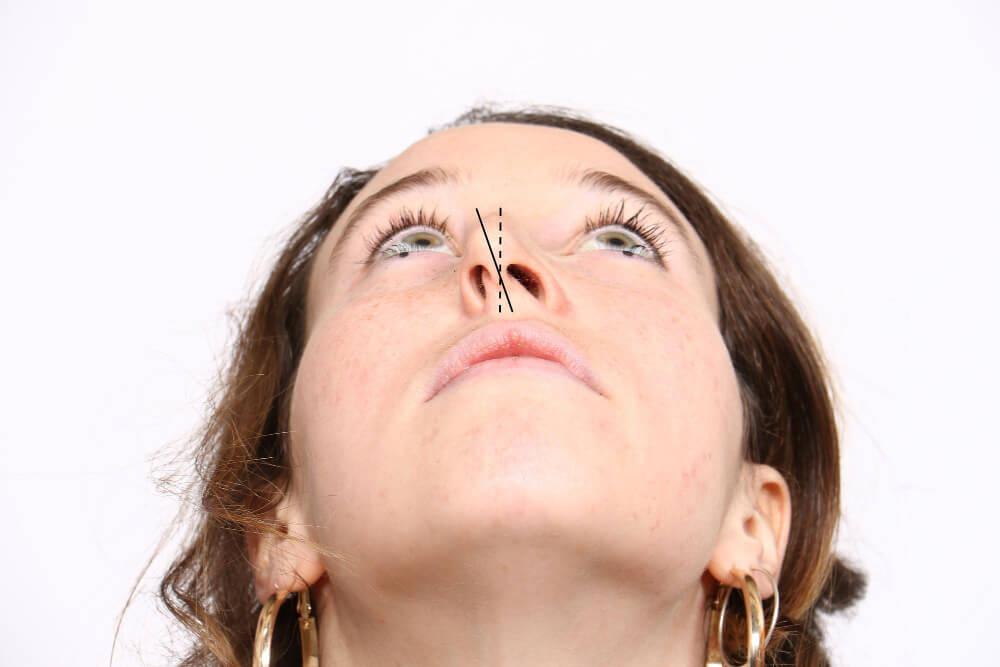$8,995
Struggling to Breathe Through Your Nose?
A deviated septum affects breathing quality and disrupts sleep, making daily activities more difficult than they should be. The constant nasal congestion, frequent sinus infections, and poor sleep quality take their toll on overall health and well-being.
Septoplasty surgery offers a permanent solution to restore normal breathing function. Dr. Craig Jonov, and Dr. David Santos at Seattle Plastic Surgery perform septoplasty to correct deviated septums and improve nasal airflow for patients throughout Seattle.
What Is Septoplasty Surgery?
Septoplasty is a surgical procedure designed to straighten the nasal septum and restore proper airflow through the nasal passages. The septum is the wall of cartilage and bone that divides the nasal cavity into two nostrils. When this structure becomes crooked or displaced, it blocks one or both nasal passages, causing breathing difficulties.
The surgeons at Seattle Plastic Surgery correct the deviation by repositioning and reshaping the septum to its proper alignment. Unlike cosmetic rhinoplasty, septoplasty focuses exclusively on improving nasal function rather than changing the external appearance of the nose. The procedure addresses structural problems inside the nose that prevent normal breathing.


How Does Septoplasty Correct a Deviated Septum?
During septoplasty surgery, the surgeon makes small incisions inside the nostrils to access the septum. No external cuts or visible scars result from this approach. Through these internal incisions, the surgeon carefully lifts the mucous membrane covering the septum.
The deviated portions of cartilage and bone causing the obstruction are then removed or repositioned. The septum gets straightened and moved to the center of the nose. Once properly aligned, the mucous membrane is repositioned over the newly straightened septum. The entire procedure typically takes between 30 to 90 minutes, depending on the severity of the deviation.
Benefits of Septoplasty
Septoplasty in Seattle provides numerous improvements to quality of life:
- Improved Breathing: Clear nasal passages allow normal airflow through both nostrils
- Better Sleep Quality: Reduced snoring and elimination of sleep disruptions from breathing difficulties
- Fewer Sinus Infections: Proper drainage prevents bacteria buildup in the sinuses
- Enhanced Exercise Performance: Increased oxygen intake during physical activities
- Reduced Headaches: Relief from sinus pressure and tension headaches
- Decreased Nosebleeds: Correcting airflow reduces drying and irritation
- Improved Sense of Smell: Better airflow enhances the ability to detect scents

Who Is a Good Candidate for Septoplasty?
Ideal candidates for septoplasty experience chronic breathing difficulties due to a deviated septum. Symptoms that indicate potential candidacy include persistent nasal congestion affecting one or both sides, frequent sinus infections, recurring nosebleeds, facial pain or pressure, loud snoring or sleep apnea, and difficulty breathing during exercise.
Patients should be in good general health for surgery. Non-smokers or those willing to quit before surgery see better healing results. The nasal structure should be fully developed, typically by age 15 or 16. Previous unsuccessful medical treatments like decongestants or nasal sprays, often lead patients to consider surgical correction.
During consultation, the surgeon evaluates each patient’s nasal anatomy to determine if septoplasty will address their specific concerns. Some breathing issues stem from other causes, such as allergies or nasal polyps, which require different treatments.
Septoplasty vs. Rhinoplasty: Understanding the Difference
While both procedures involve nasal surgery, septoplasty and rhinoplasty serve different purposes. Septoplasty corrects internal structural issues that affect breathing function. The surgery focuses entirely on medical necessity rather than cosmetic enhancement. Insurance often covers septoplasty when medically indicated.
Rhinoplasty reshapes the external nose for aesthetic purposes. This cosmetic procedure changes the size, shape, or proportions of the nose. Patients choose rhinoplasty to enhance facial harmony or correct cosmetic imperfections.
Some patients benefit from combining both procedures. The surgeons at Seattle Plastic Surgery perform septorhinoplasty when patients need functional correction along with cosmetic refinement. This combined approach addresses breathing problems while improving nasal appearance in a single surgery.
The Septoplasty Procedure
Septoplasty surgery at Seattle Plastic Surgery is performed using a carefully planned approach tailored to each patient’s unique anatomy. The procedure is performed in a state-licensed surgery center, using either local anesthesia with sedation or general anesthesia, based on the patient’s preference and medical factors.
The surgery begins with incisions made entirely inside the nostrils. The surgeon gently lifts the soft tissue lining the septum to expose the underlying cartilage and bone. Using specialized instruments, the deviated portions are removed, and the remaining structures are realigned to be straight.
Splints or soft packing may be placed inside the nose to support healing tissues. These temporary supports typically remain for one week after surgery. The surgeons use dissolvable sutures when possible to minimize follow-up care requirements.
Septoplasty Recovery
Recovery from septoplasty progresses steadily with proper care and attention. Most patients return home the same day as surgery. The first week involves the most significant healing, with congestion and mild discomfort being regular. Pain medication manages any discomfort effectively.
Patients typically return to work or school within one week; however, strenuous activities should be avoided for three to four weeks. The surgical team provides detailed recovery instructions, including:
- Sleeping with the head elevated to reduce swelling
- Avoiding nose blowing for the first week
- Using saline rinses to keep nasal passages moist
- Taking prescribed medications as directed
- Attending follow-up appointments for monitoring
Full healing occurs gradually over several months as internal swelling resolves completely. Most patients notice an immediate improvement in breathing once the initial swelling subsides, with continued enhancement as healing progresses.
Is Septoplasty a Permanent Solution?
Septoplasty provides permanent correction of the deviated septum in most cases. Once the septum is surgically straightened, it typically maintains its new position indefinitely. The structural changes made during surgery do not reverse over time.
However, nasal trauma after surgery could potentially cause a new deviation. Contact sports participants should wear protective equipment to prevent reinjury. Natural aging may cause minor changes to the nasal structures, but these rarely significantly affect the results of septoplasty.
Some patients may still experience seasonal allergies or other non-structural breathing issues after septoplasty. These conditions require separate management but do not indicate septoplasty failure. The surgery specifically addresses structural obstruction rather than all possible causes of nasal congestion.
Combining Septoplasty With Other Procedures
Many patients choose to address multiple concerns during septoplasty surgery. Common combinations include:
Turbinate Reduction: Enlarged turbinates often accompany septal deviations. Reducing these structures further improves breathing.
Sinus Surgery: Patients with chronic sinusitis benefit from opening blocked sinus passages during septoplasty.
Rhinoplasty: Patients wanting aesthetic improvements combine functional and cosmetic nasal surgery.
However, surgeons evaluate each patient’s needs to determine the appropriate combinations.
Septoplasty Cost in Seattle
The cost of septoplasty at Seattle Plastic Surgery is $8,995. This comprehensive price includes the surgery fee, surgeon’s fee, anesthesia fee, operating room fees, post-surgical garment, sales tax, and all post-procedure appointments. Medications are not included in this price and will be an additional expense.
During consultation, patients receive a detailed breakdown of all costs associated with their septoplasty surgery. The transparent pricing structure ensures patients understand exactly what their investment covers before proceeding with treatment.
Schedule Your Septoplasty Consultation
Take the first step toward breathing freely again. Patients can schedule a consultation with Dr. Jonov, Dr. Patel, or Dr. Santos to evaluate nasal anatomy and discuss how septoplasty in Seattle can address specific concerns. The consultation includes an examination of the nasal structures, a review of symptoms and medical history, and personalized treatment recommendations.
Contact Seattle Plastic Surgery at (206) 324-1120 or visit Price Simulator to schedule a consultation for a septoplasty. The experienced team answers questions and guides patients through every step of the treatment process.
Interested in a Septoplasty?
Fill out the form below to schedule an appointment or ask us any questions you may have.
Frequently Asked Questions
What is septoplasty surgery?
Septoplasty is a surgical procedure that straightens a deviated nasal septum to improve breathing. The surgery corrects the wall between nostrils when it blocks airflow through one or both nasal passages.
How does septoplasty correct a deviated septum?
The surgeon makes incisions inside the nose to access the septum, then removes or repositions deviated cartilage and bone. The septum gets straightened and centered to open blocked nasal passages.
What are the benefits of septoplasty?
Benefits include improved breathing, better sleep quality, fewer sinus infections, reduced snoring, decreased nosebleeds, relief from sinus headaches, and enhanced ability to smell.
Who is a good candidate for septoplasty?
Good candidates have chronic nasal obstruction from a deviated septum, are in good general health, have realistic expectations, and have tried conservative treatments without success.
How is septoplasty different from rhinoplasty?
Septoplasty corrects internal structural problems to improve breathing function. Rhinoplasty reshapes the external nose for cosmetic purposes. Patients can combine both procedures when needed.
What happens during a septoplasty procedure?
The surgeon makes internal incisions, lifts the membrane covering the septum, removes or repositions deviated portions, straightens the septum, and replaces the membrane. The procedure takes 30 to 90 minutes.
How long does it take to recover from septoplasty?
Initial recovery takes about one week, with return to normal activities in two to three weeks. Complete healing continues for several months as internal swelling resolves completely.
Is septoplasty a permanent solution for breathing problems?
Yes, septoplasty permanently corrects the structural deviation. However, other causes of nasal congestion, like allergies, may still require separate treatment after surgery.
What risks or complications are associated with septoplasty?
Potential risks include bleeding, infection, changes in nasal shape, persistent symptoms, septal perforation, and temporary numbness. Complications remain rare with experienced surgeons.
How much does septoplasty cost?
Septoplasty cost at Seattle Plastic Surgery is $8,995, which includes surgery fee, surgeon’s fee, anesthesia fee, operating room fees, post-surgical garment, sales tax, and all post-procedure appointments. Medications are not included.
STILL HAVE QUESTIONS?
Give us a call at 206-324-1120.Or, chat by clicking the icon in the lower left hand corner of your screen. Additionally, you can contact us by filling out the form above.

